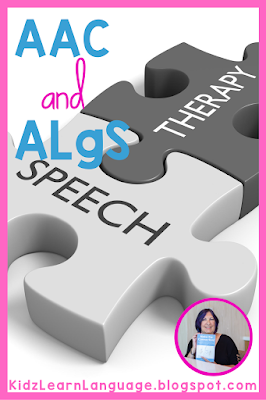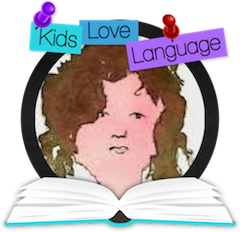The key to successful implementation of AAC with a new user is partners’ use of Aided Language Stimulation (ALgS). ALgS is a specific strategy, whereby the communication partner teaches the meaning of the symbols and models language by combining his own verbalizations/speech with the selection of key vocabulary on the AAC system.
The intent is not for the partner to use a symbol for every word in his/her sentence, but rather to highlight the key, core words by using those symbols on the AAC system while talking to the student.
Why do we use Aided Language Stimulation? Think about learning to use AAC as if it were like learning a new language.
If you want someone to learn a new language to have to expose them to it, speak it with them so they get practice with it, give them multiple opportunities to see and hear it. It also gives us the opportunity to become familiar with the AAC system, so that we can use it with the student in interventions competently.
It takes time and practice to get good at this. Allow yourself some wiggle room and don’t get down on yourself if you find it difficult and you start out inconsistent.
I recommend starting with a single, easy activity. One where you can predict what you’re going to want to say and, most likely, what the student probably will want to say in that context.
Plan it out. Write down those word, phrases, sentences. Look for them on the AAC system. Practice finding and using them. Then….. Go for it! With just that one activity start modeling symbol use.
Provide models that are at or just above the student’s language level. For new users, who are just starting to find single words - or even those who haven’t used any - I recommend starting by providing 1,2, and sometimes even 3 symbols when modeling.
Don’t worry about being slow. Yes, there are those users whose attention is fleeting and, if you’re not fast enough, you can lose them. That’s ok, just keep modeling. Many students will appreciate the additional time they have for processing linguistic input, which often moves too quickly for them.
Take a look back at this post to get an idea of what I mean. (Pretty colors and fancy shapes not needed.)
Keep on Talking - verbally and with pictures!




Thanks for sharing your encouragement and expertise regarding the AAC system.
ReplyDeleteYou're welcome, Christina. I hope I'm getting information out to those who need it. Thanks for reading.
DeleteI'm going to have to read all of your posts! Very interesting. I went back to your first post to learn what AAC stands for (I'm not familiar with it), but your information may be very helpful, as my 8-year-old has a speech and language delay. Thank you for sharing!
ReplyDeleteYou're welcome. And thanks for the reminder that I should define the term! Good luck with your son. Thanks for reading.
DeleteInteresting topic, I'm not familiar with it but I can see the benefits of using it with struggling learners.
ReplyDeleteData reporting fluctuates, but it is said that roughly 40% of kids with autism are nonverbal or not sufficiently verbal to meet their needs. Add to that the kids with c.p. who are not intelligible, kids with severe t.b.i. and others. So, I do try to disseminate what I know. Thanks so much for reading.
DeleteVery interesting topic. I think that recognizing different learning styles across the curriculum is important. Thanks for sharing these ideas.
ReplyDeleteCheers
Thanks for reading. There are so many kids out there who do not speak, or not enough to get their needs met. I try to share information as much as I can.
DeleteThanks so much for sharing this information about the AAC app. This is very new to me, but I find it very interesting. I have a teacher friend with a nonverbal student and I am going to forward your post to her.
ReplyDeleteBest wishes!
Jen :)
Thanks for reading, Jen. And for passing the information along to a teacher who need it. Sharing what we know and hear about with one another is one of the great things about out professions - people really do collaborate and share.
Delete